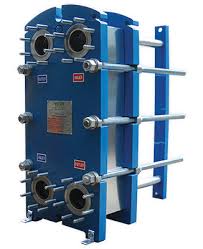Plate Heat Exchangers
About
A plate heat exchangers is a type of heat exchanger that uses metal plates to transfer heat between two fluids. This has a major advantage over a conventional heat exchanger in that the fluids are exposed to a much larger surface area because the fluids are spread out over the plates. Is a piece of equipment built for efficient heat transfer from one medium to another. They are widely used in space heating, refrigeration, air conditioning, power plants, chemical plants, petrochemical plants, petroleum refineries, natural gas processing and sewage treatment. In heat exchangers, there are usually no external heat and work interactions.
Common examples of heat exchangers are :- shell-and- tube exchangers, automobile radiators, condensers, evaporators, air pre-heaters, and cooling towers.
Features
- Compact design
- High performance rate
- Simple functioning
- Easy to maintain
- High grade material
- Low noise operation
Types of Heat Exchangers
- Plate
- Double pipe heat
- Shell and tube
- Plate and shell
- Spiral
- Plate fin
What is a plate type heat exchangers ?
- It’s a type of Heat Exchangers which consists of many corrugated stainless- steel sheets separated by polymer gaskets and clamped into a steel frame .
Parts & Their Function
1.Frame
The frame is made up of thick steel pressure retaining parts, the fixed cover and the movable cover, that when pulled together with the tightening bolts form the pressure retaining structure for the plates / plate pack . The carrying bar and guide bar act as a carrier and guide to both the plates and the movable cover
2. Plates
The heat exchanger plates, which make up the heat transfer surface, are clamped between two plates of steel with the use of the tightening bolts. The heat exchanger construction allows a plate heat exchanger to be easily opened for inspection and cleaning.
3. Gaskets
Each plate has a gasket that produces a sealing and channel system through the entire plate pack in which the two heat exchanging media flow in a counter-current direction. The circular portion of the gasket stops the fluid from going across the heat transfer plate and sends it to the next open channel. The remaining portion or field gasket directs the opposing fluid across the heat transfer surface.
4. Flow Arrangement
The heat transfer plates with gaskets are arranged in an alternating pattern of left hand flow and right hand flow to direct the fluids in an opposing direction within the heat exchanger. The completed assembly of all the plates and gaskets is called the “plate pack.”
Classification
- Gasket-ed (plate and frame heat exchangers).
- Brazed .
- Welded.
Benefits
- Lightweight
- Lower liquid volume
- Quick process control
- Lower cost
- High-viscosity applications
- Saves space and servicing time
Images
